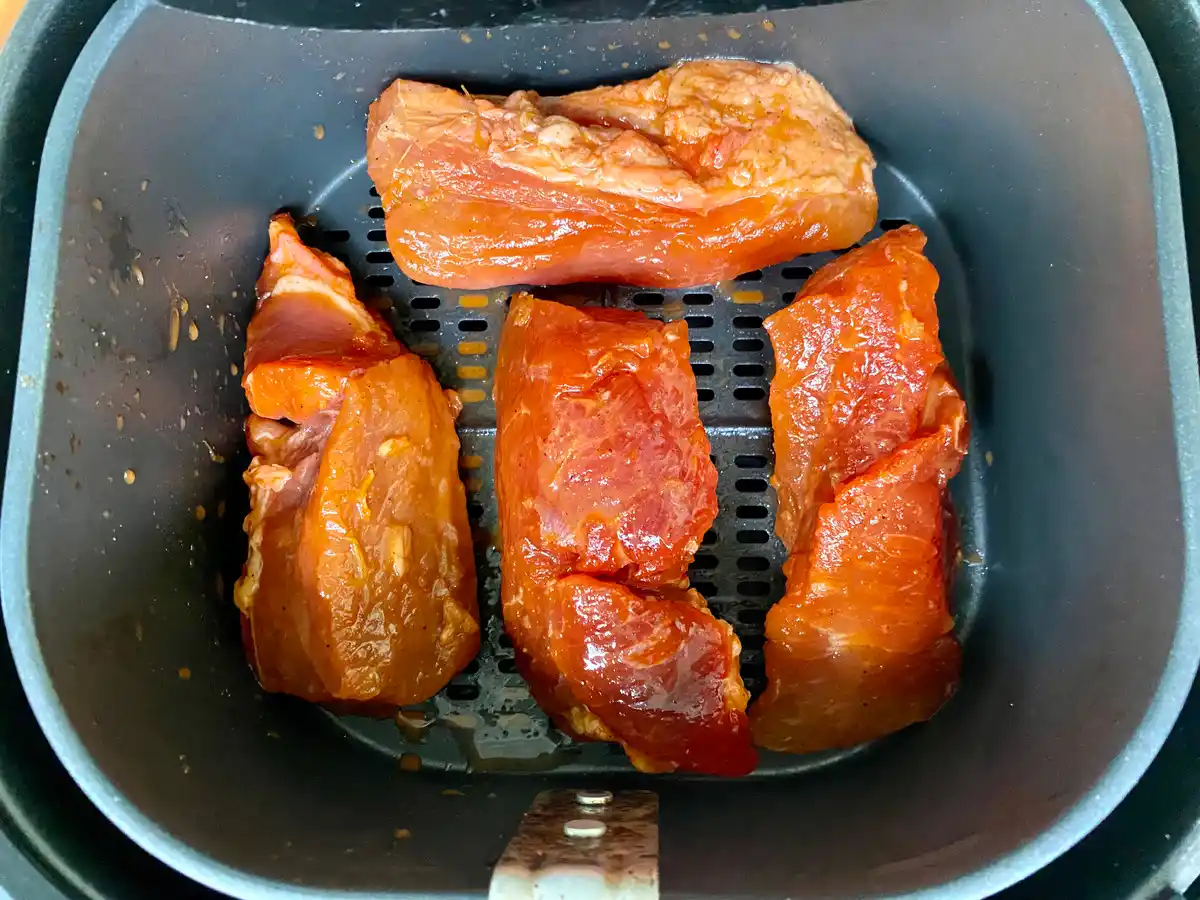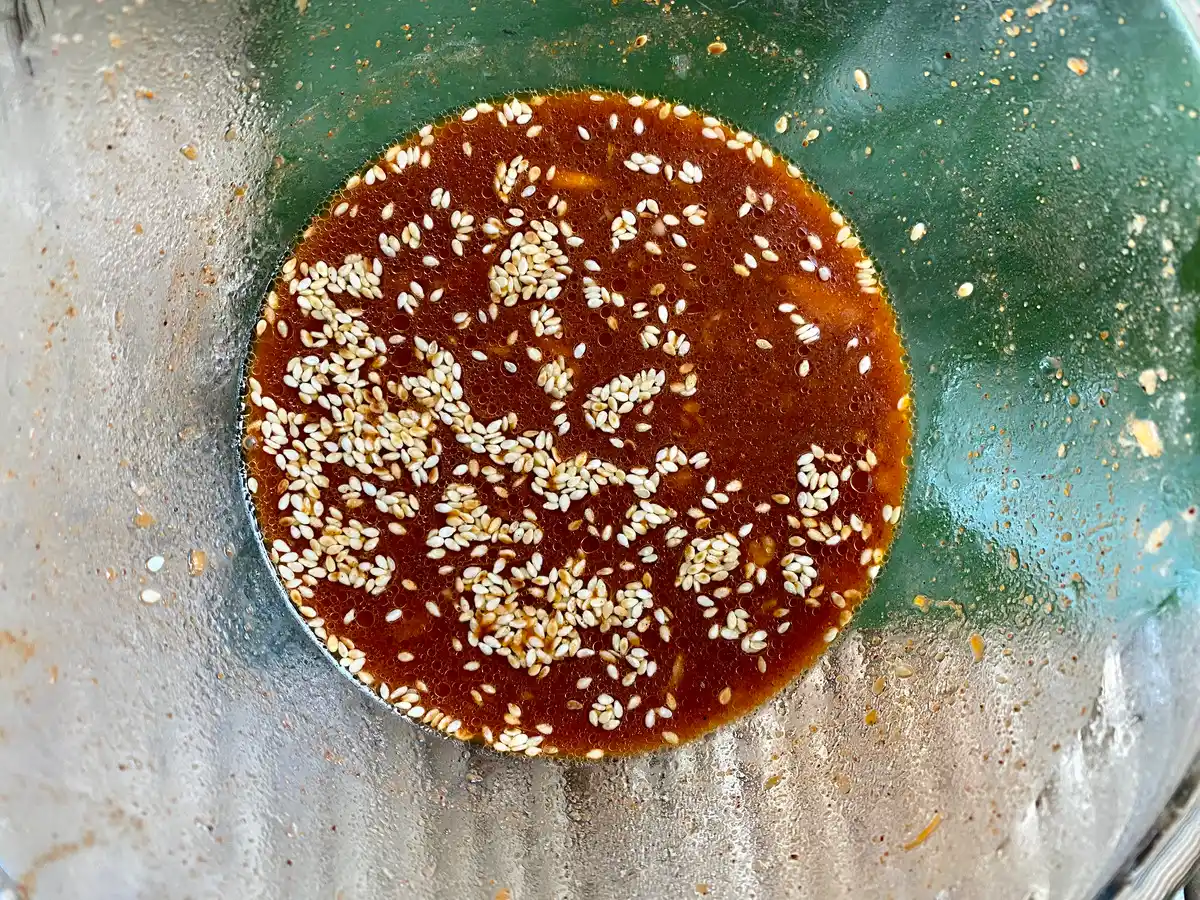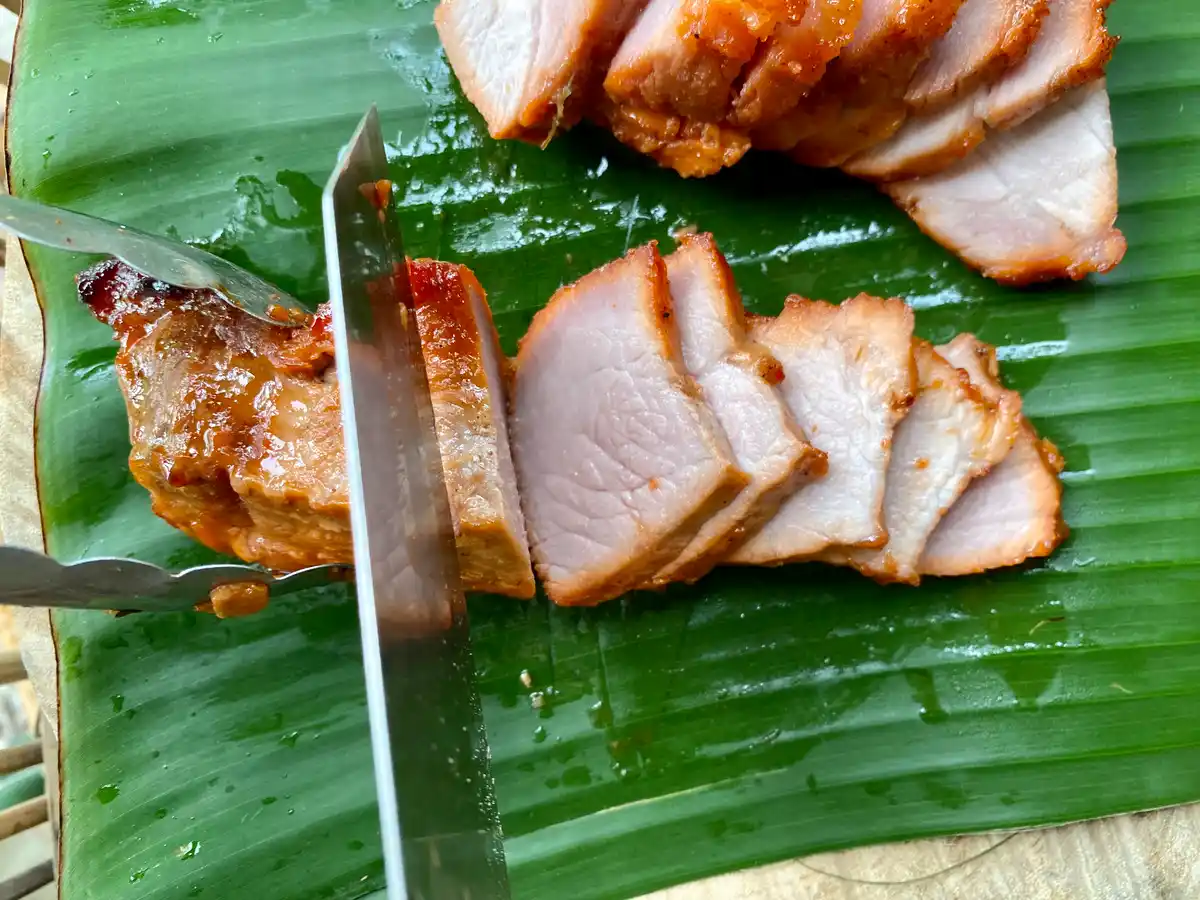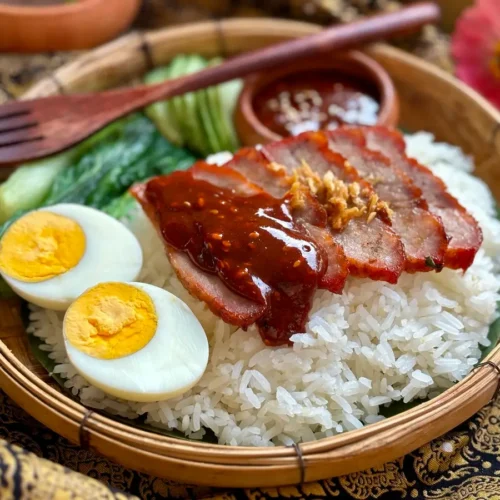Jump to Recipe Print Recipe
Khao moo dang recipe, a twist on Chinese red pork, makes a delicious fusion dish of Thai and Chinese cuisine. With just a few simple ingredients, you can recreate this beloved street food classic in your own kitchen. Simple, easy, and prepared just like in Thailand!
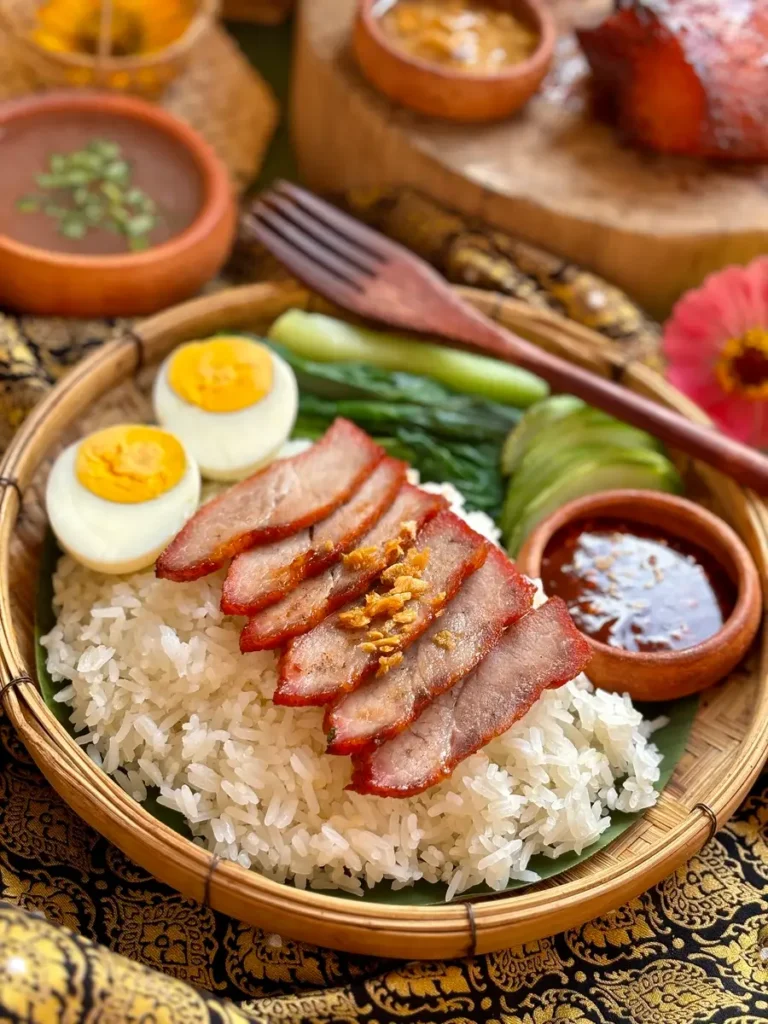
Don’t miss out on my favorite Thai BBQ pork dishes! Try my irresistible moo ping (grilled pork skewers), nam tok moo, mookata , and moo yang for Thai grilled pork.
Khao moo dang is a popular Thai dish featuring slices of juicy pork, served with steamed jasmine rice. The Thai barbecue pork is always drizzled with a sweet and savory red sauce and is a blend of Thai-Chinese cuisine.What is khao moo dang
The word “khao” means “rice,” and “moo dang” means red pork (roasted or barbecued). So, khao moo dang means “rice with red pork”.
Thai char siu
Thai-style BBQ pork, or khao moo dang, came from Chinese immigrants. They brought their cooking styles and mixed them with Thai ingredients and flavors. This created new, unique tastes that are a mix of both cultures.
Red roasted pork is a big deal in Chinese cooking, where it’s known as ‘char siu’ (叉燒). In Thailand, we turned it into our own version called khao moo dang. We use Thai seasonings and sauces to make it just right for us.
Thai red pork
Thai roasted pork with rice is one of my all-time favorite dishes ever. When I spot it on the menu at a Thai restaurant, I never have to think twice.
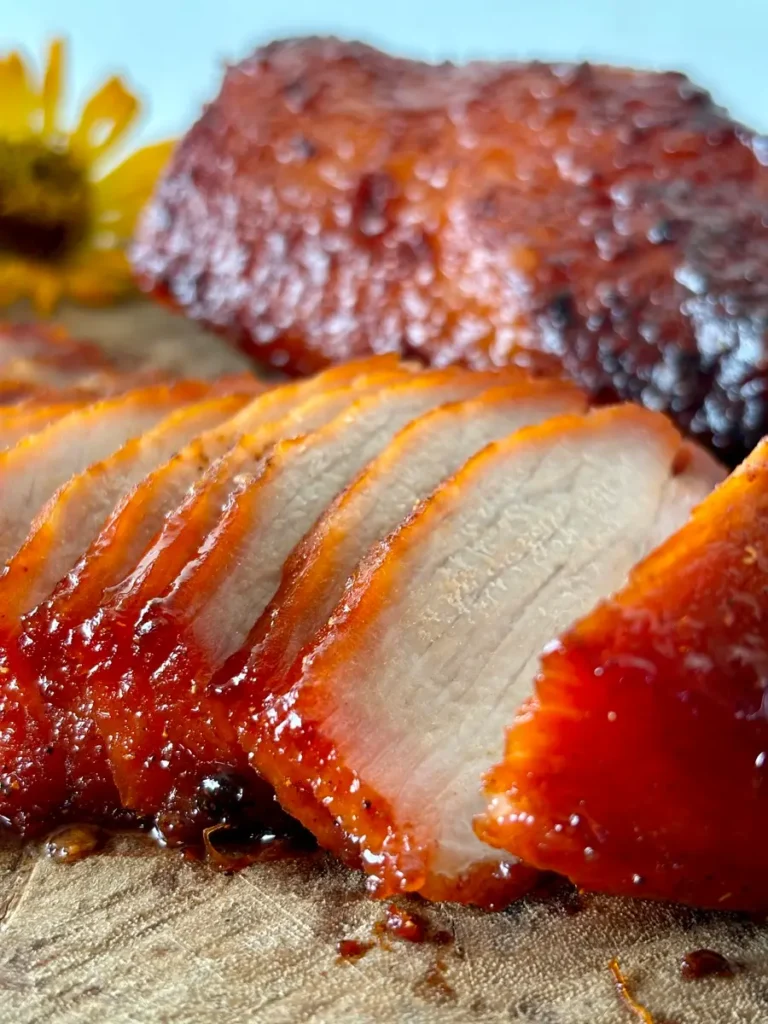
It comes with tender slices of pork bathing in a savory, slightly sweet, and umami-rich sauce that you won’t get enough of. The meat is often served over a bed of steamed rice with a side of healthy cucumber slices.
The marinade, a delicious mix of traditional Thai ingredients and a dash of Chinese five-spice powder, infuses the meat with an irresistible taste and aroma. The pork rests in the marinade until it reaches a melt-in-your-mouth tenderness.
No khao moo dang recipe is complete without an extraordinary sauce, and this recipe doesn’t disappoint. The perfect balance between Thai and Chinese flavors make this dish taste like it came straight from Bangkok’s street food stalls.
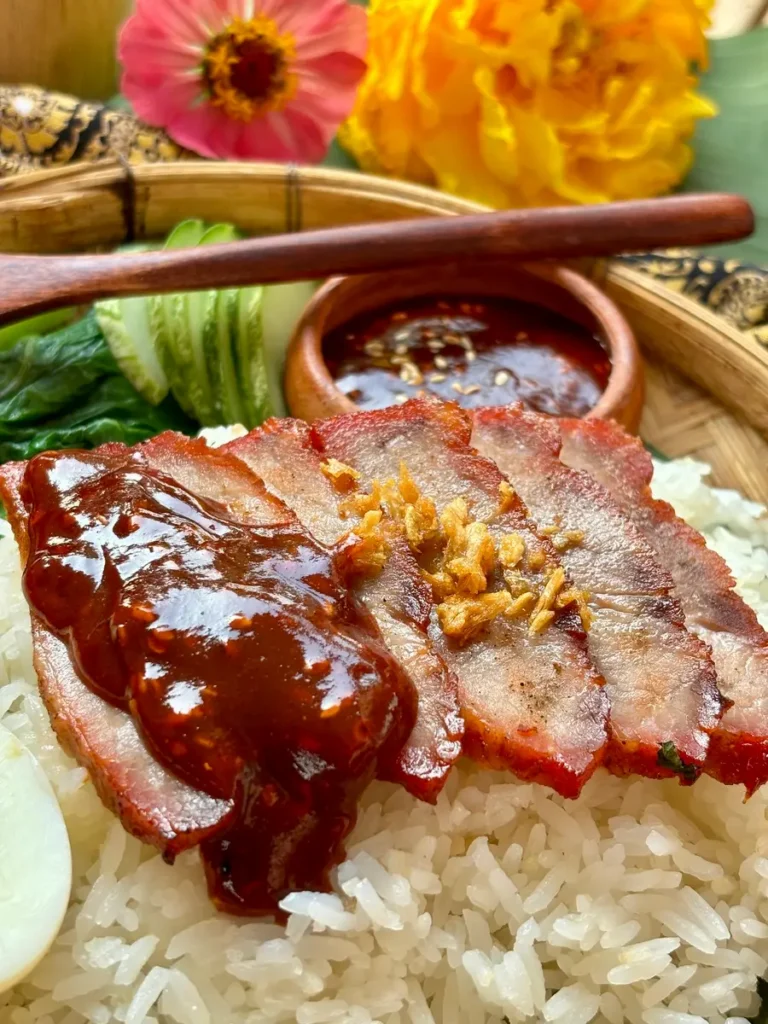
I’m a big fan of fusion food, and this red BBQ pork brings out the best of both worlds. If you love Thai and Chinese fusion dishes as much as I do, you’ll want to try my popular beef pad see ew next!
Why try Thai-style roasted pork
Authentic and rewarding: Asian cuisine is not just delicious; it’s often a feast for your eyes as well, and this recipe is no exception. Making Thai pork from scratch and assembling your plate is incredibly rewarding!
Crowd-pleaser: It’s a healthy, light, and fulfilling meal that both adults and kids love. Plus, preparing food yourself is always healthier than getting takeout.
Easy to make: This recipe might seem complicated, but it’s far from that, in fact it’s pretty easy to make. It’s not the quickest, but you don’t have to be a Thai food chef to whip it up.
Aromatic: You’ll love the aroma that fills up your kitchen while the Thai pork is simmering.
Ingredients
The ingredients are divided into two sections. One set is needed for marinating the pork, and the other is used to prepare the red sauce for drizzling over the roasted pork.
Ingredients can be sourced at Asian grocery stores and Asian markets.
The exact measurements are in the recipe card at the end of this post.
Pork marinade
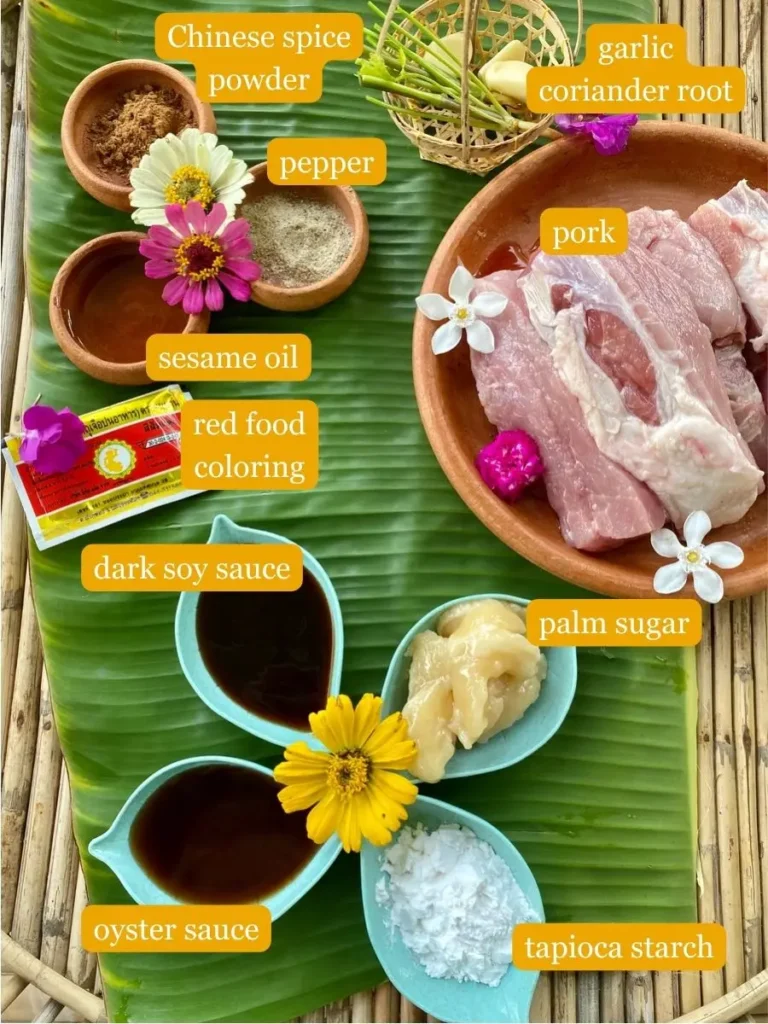
- Pork – The best cut of pork for khao moo dang is pork shoulder or Boston butt. These cuts stay tender during cooking. For a lean alternative, you can opt for pork chops or loin. Slice it lengthwise, following the grain, into long strips. This technique is used to create thin, long slices of pork that will cook evenly and absorb marinades and sauces well. Aim to include a portion of fat on each slice of pork.
- Coriander root – Coriander root brings a unique, earthy depth that powdered spices can’t match. It melds with the other ingredients and creates an aromatic base.
- Palm sugar – A staple in Thai cuisine, adding a caramel-like sweetness to our dishes. It balances out the savory notes. To replicate the exact flavors of this recipe, avoid using brown sugar or white sugar.
- Light soy sauce – A key ingredient in Thai food, it brings a savory and salty flavor to the marinade.
- Oyster sauce – Oyster sauce is a thick, brown sauce that deepens the savory notes and adds a touch of sweetness to the marinade.
- Chinese five spice powder – Chinese five spice powder is a blend of aromatic spices like cinnamon, cloves, fennel, star anise, and Sichuan peppercorns.
- White pepper – White pepper adds a mild heat that complements the other flavors without overwhelming them.
- Sesame oil – Brings a nutty touch and a hint of richness that’s irreplaceable.
- Red food coloring – That iconic red hue is part of the khao moo dang charm. A little goes a long way.
- Tapioca starch – Here’s your thickening agent, the key to a glossy, cling-to-the-meat sauce.
- Garlic – Garlic is pungent and earthy, an essential in the marinade.
Moo dang sauce
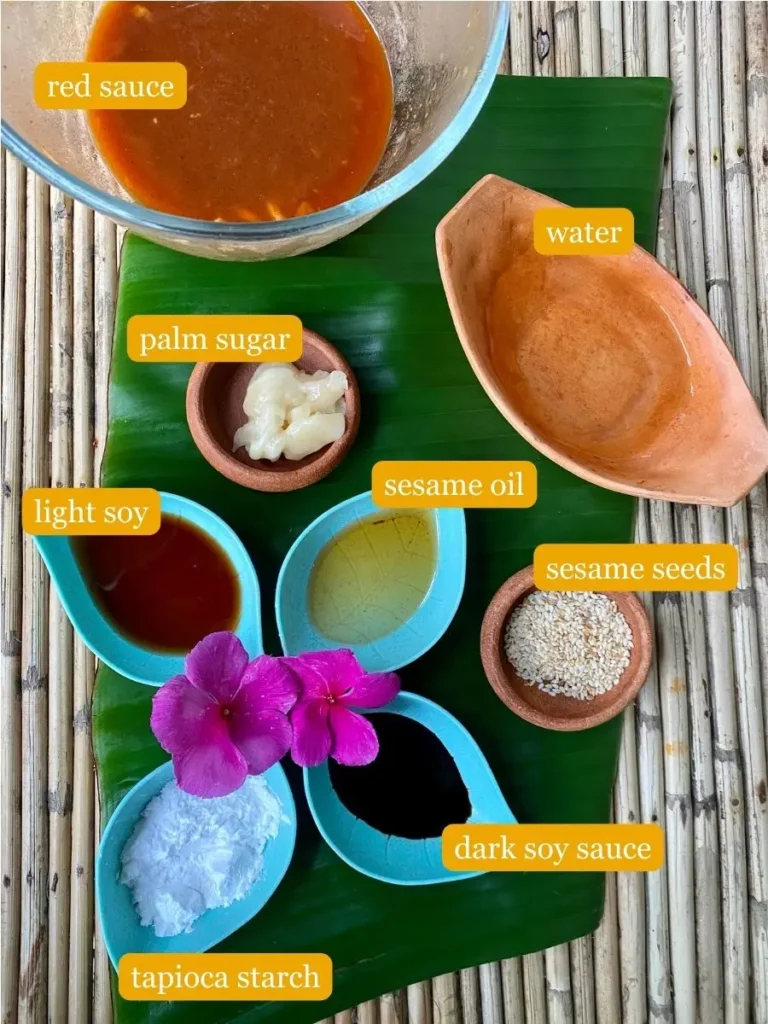
- Red sauce – This is the leftover sauce in which the pork was marinated.
- Roasted sesame seeds
- Light soy sauce
- Dark soy sauce
- Palm sugar
- Sesame oil
- Water
- Tapioca starch (optional) – While cooking the sauce, you can add a mix of tapioca starch and water to make the sauce even thicker if you want to.
How to make kao moo dang recipe
Step 1: Crush garlic and coriander root with a mortar and pestle.
Step 2: In a large mixing bowl, combine the garlic & coriander root mixture, Chinese five spice powder, white pepper, palm sugar, sesame oil, oyster sauce, light soy sauce, and tapioca starch. Add food coloring and thoroughly mix one more time.
Step 3: Add pork and coat each part with the sauce. Marinate in your refrigerator overnight. (Afterward, keep the marinade sauce – don’t discard it!!)
Step 4 Air fryer method: Place the meat in a single layer and cook at 320°F / 160°C for 10 minutes, then flip and cook the other side for 10 more minutes. After cooking the pork, let it rest for a few minutes before slicing to enhance its tenderness and evenly distribute the juices. While it rests, you can whip up the sauce.
Step 4.1 Grilling method: Grill your pork over charcoal until it’s fully cooked, flipping occasionally to prevent burning. Alternatively, you can use a grilling pan.
Step 5: Add palm sugar, sesame oil, sesame seeds, dark soy sauce, and light soy sauce into the leftover marinade sauce and mix thoroughly.
Step 6: Move the sauce to a pot or wok over medium heat. Once it starts bubbling, pour in water. If the sauce isn’t your desired thickness, consider mixing the optional tapioca starch with 5 fl oz of water. Add gradually and stir until it’s just right.
Step 7: Slice the pork against the grain into thin strips.
Step 8: Place a generous serving of steamed jasmine rice on a plate, then top it with slices of Thai red pork. Generously drizzle the sauce over the pork, and garnish with sliced cucumber and hard-boiled eggs.
Kitchen tools
- Air fryer, charcoal grill, or grilling pan for cooking the pork
- Measuring spoons and cups for measuring the ingredients
- Cutting board and sharp knife for slicing the pork
- Mixing bowl for marinating and mixing the sauce
- Meat thermometer for checking doneness
- Saucepan for making the red sauce
- Tongs for flipping the pork
Tips for the best BBQ pork
Room temperature meat: After marinating, let the meat come to room temperature before cooking it, this helps cooking it evenly.
Marinate overnight: For the best flavor, marinate the pork overnight.
Balancing flavors: Taste as you go and adjust the seasoning of your sauce. Balance is key in Thai cooking.
Resting the meat: Always let the meat rest after cooking and before slicing to retain its juices.
Control the heat: Avoid overcooking the pork, it should be juicy and tender.
How to serve
Start by spooning your steamed jasmine rice onto a plate. Top it with slices of Thai red pork and drizzle generously with that irresistible red sauce. Garnish with crisp sliced cucumber and halved hard-boiled eggs for a pop of color and freshness. A sprinkle of cilantro leaves and chopped green onions adds the perfect finishing touch.
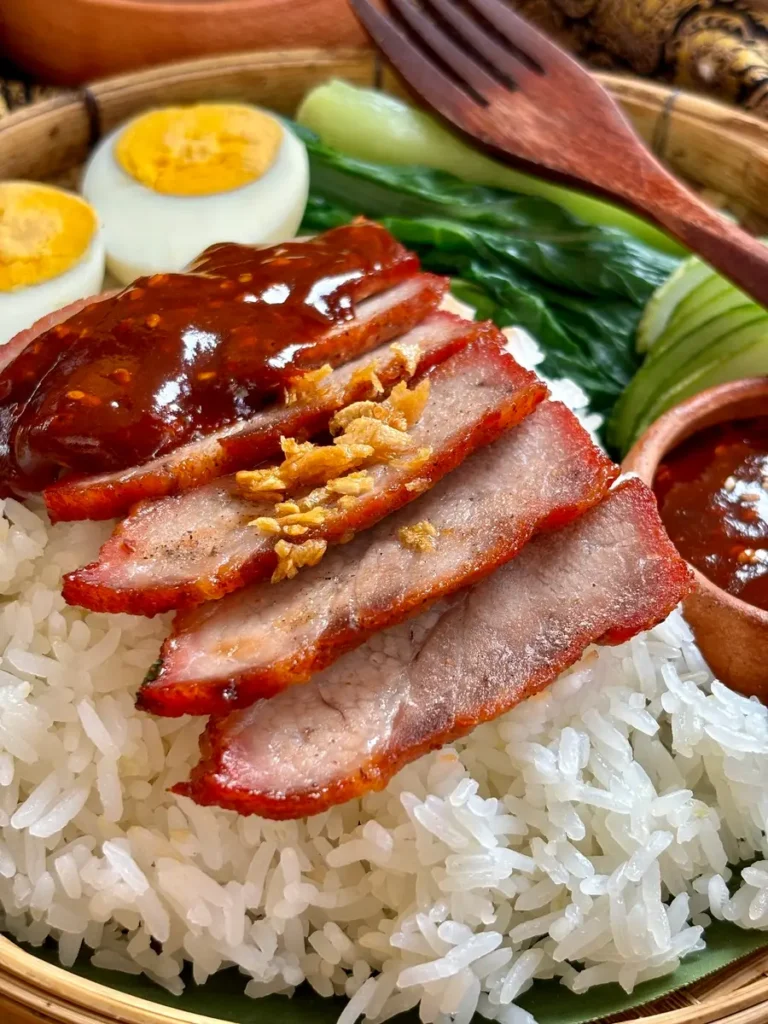
Feel free to add a side of fresh vegetables like green beans, lettuce, and carrots. Sprinkle the pork with roasted sesame seeds for extra flavor. For a spicy kick, add sliced red chili peppers or a side of nam jim jaew, a Thai spicy sauce.
To serve with other Thai dishes, try som tum Thai (green papaya salad) and authentic chicken pad Thai.
How to store Thai roast pork
Let your Thai red pork leftovers cool to room temperature, then place it in an airtight container and keep it in the fridge for up to 3 days. If you can, keep the sauce separate.
Freezing: Put the pork slices in a freezer bag or container. They’ll last up to 3 months. Thaw in the fridge or microwave when you’re ready to eat.
Reheating: Simply reheat your khao moo daeng on the stove top or use the microwave.
Frequently asked questions
Can I make this with other protein?
I honestly haven’t heard of Thai variations with other meat, or haven’t tried it myself either. However, I think boneless chicken thighs or breast makes a great choice as it’s tender and lean. Just follow the same marinade and instructions but adjust the cooking time as needed.
Is khao moo dang spicy?
No, khao moo dang is not spicy. However, it can be served with chili peppers or spicy dipping sauces for those who prefer a little heat.
More Thai pork recipes you’ll love
- Hot and spicy pork rinds recipe
- Thai fried pork belly recipe
- Thai green curry pork
- Thai basil pork belly
- Pad kana moo krob
- Thai pork larb
- Pad kra pao
Loved reading this long beans stir-fry recipe? Please make my day by dropping a star rating and/or a comment below! Follow me onFacebook,Instagram, andPinterest.
Khao Moo Dang Recipe (Thai Red Pork)
Authentic recipe for khao moo dang with juicy red pork drizzled with the most delicious savory-sweet sauce you've ever tasted.
Praew
Prep Time 10 minutes minutes
Cook Time 30 minutes minutes
Total Time 40 minutes minutes
Cuisine Thai
Course Main Course
Serving Size 3 people
Ingredients
PORK MARINADE
- 3 cloves garlic
- 2 coriander root
- 1.5 tablespoon Chinese five spice powder
- 1 teaspoon white pepper
- 4 tablespoons palm sugar
- 1/2 tablespoon sesame oil
- 2 tablespoons oyster sauce
- 2 tablespoons light soy sauce
- 1/2 tablespoon tapioca starch
- 1/4 teaspoon red food coloring
- 18 ounces pork pork loin
RED SAUCE
- 1 tablespoon palm sugar
- 1/2 tablespoon sesame oil
- 1/2 tablespoon roasted sesame seeds
- 1/2 teaspoon dark soy sauce
- 1 tablespoon light soy sauce
- 5 fluid ounces red sauce from marinating the pork
- 5 fluid ounces water
- 1 teaspoon tapioca starch optional, for thickening the sauce, mix with water
Instructions
MARINATE PORK
Crush garlic and coriander root with a mortar and pestle.
In a large mixing bowl, combine the garlic & coriander root mixture, Chinese five spice powder, white pepper, palm sugar, sesame oil, oyster sauce, light soy sauce, and tapioca starch. Add the food coloring and thoroughly mix one more time.
Add pork and coat each part with the sauce. Marinate in your refrigerator overnight. (Afterward, keep the marinade sauce – don’t discard it!!)
COOK PORK
AIR FRYER METHOD: Place the meat in a single layer and cook at 320°F / 160°C for 15 minutes, then flip and cook the other side for 5 more minutes. After cooking the pork, let it rest for a few minutes before slicing to enhance its tenderness and evenly distribute the juices. While it rests, you can whip up the sauce.
GRILLING METHOD: Grill your pork over charcoal until it’s fully cooked, flipping occasionally to prevent burning. Alternatively, you can use a grilling pan.
MAKE RED SAUCE
Add palm sugar, sesame oil, sesame seeds, dark soy sauce, and light soy sauce into the leftover marinade sauce and mix thoroughly.
Move the sauce to a pot or wok over medium heat. Once it starts bubbling, pour in water. If the sauce isn’t your desired thickness, consider mixing the optional tapioca starch with 5 fl oz of water. Add gradually and stir until it’s just right.
SERVE
Slice the pork against the grain into thin strips.
Place a generous serving of steamed jasmine rice on a plate, then top it with slices of Thai red pork. Generously drizzle the sauce over the pork, and garnish with sliced cucumber and hard-boiled eggs.
Notes
- Use the nutrition card in this recipe as a guideline.
- To serve: Start by arranging a serving of steamed jasmine rice in a large dish. Press steamed rice into a bowl using a spoon and then flip it onto a plate to create a dome-shaped rice serving. Then, arrange the slices of Thai red pork on top of the rice. Drizzle a generous portion of the sauce over the meat. Garnish with sliced cucumber and add hard-boiled eggs.

